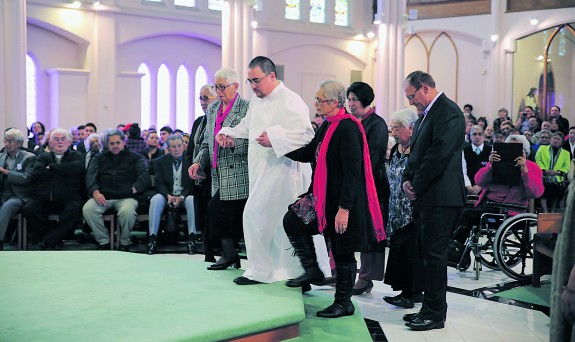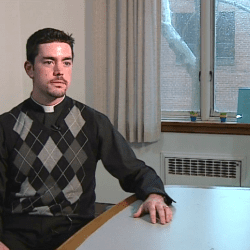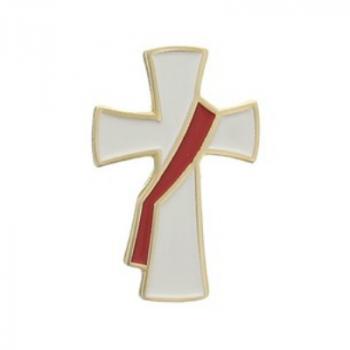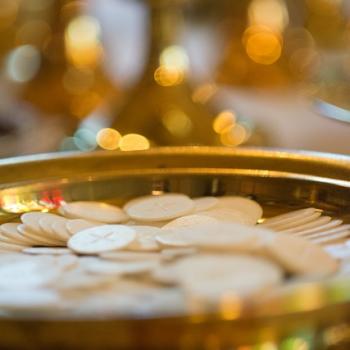Danny Karetea-Goddard at his ordination in July 2014, from New Zealand Catholic.
From Radio New Zealand:
At the most recent New Zealand Catholic Bishops Conference, Bishop Barry Jones voiced concerns that the Mass in Te Reo was slowly dying due to a lack of priests, who could conduct them in Maori.
Bishop Jones, a Pakeha, believed he is the only priest in the South Island who could speak Te Reo said the Maori Mass had been the foundation of the Catholic Church in New Zealand and it would be terrible if that aspect was lost.
Executive member of Te Runanga o Te Hāhi Katorika – the Maori Catholic Council, Danny Karatea-Goddard, said unlike 30 years ago when there were many Maori missionaries who could speak Te Reo, there were not enough new priests coming through who could speak the language.
Danny Karatea-Goddard – an executive member of Te Runanga o Te Hāhi Katorika (the Maori Catholic Council) – is one of only three Maori deacons in the country and said there was room for more.
He said unlike priests, who are celibate and cannot get married, becoming a deacon could be more of an attractive option for Maori who want a ministerial role in the church.
…He said that could be a more viable option for Maori men who want a leadership role in the church.
More about Deacon Karatea-Goddard, from New Zealand Catholic, which covered his ordination last summer:
About 600 people attended the ordination at the Cathedral of the Holy Spirit, most of them from the Maori community.
Mr Karatea-Goddard has been the Mäori spokesman for Palmerston North diocese for many years, katekita and adviser mö ngä take Mäori, first for Bishop Peter Cullinane and now for Bishop Charles Drennan. He and his wife, Maru, serve on the Runanga o te Hähi Katorika.
Mr Karatea-Goddard is a member of the Mäori translation team.
Bishop Drennan said that Mr Karatea-Goddard and his wife are already widely involved in serving the Mäori Catholic community, as well as civic groups.
“What has made a deep impression on me is the way the Mäori community itself has discerned Danny’s spiritual gifts. Mäori ministering to Mäori is a great blessing,”he said.
Mr Karatea-Goddard is half Chinese. His late mother was a leading light in the New Zealand Chinese community, earning a citation from the New Zealand Government.
Mr Karatea-Goddard said that for him, with his wife alongside and with his community, “this has been a long journey of discernment about what is best for our faith”.
Meanwhile, there’s this background about the Mäori:
According to a 2001 survey on the health of the Māori language, the number of very fluent adult speakers was about 9% of the Māori population, or 29,000 adults. A national census undertaken in 2006 says that about 4% of the New Zealand population,[5] or 23.7% of the Maori population could hold a conversation in Maori about everyday things.
…New Zealand has three official languages – English, Māori and New Zealand Sign Language. Māori gained this status with the passing of theMāori Language Act in 1987. Most government departments and agencies have bilingual names; for example, the Department of Internal AffairsTe Tari Taiwhenua, and places such as local government offices and public libraries display bilingual signs and use bilingual stationery. The New Zealand Post recognises Māori place-names in postal addresses. Dealings with government agencies may be conducted in Māori, but in practice, this almost always requires interpreters, restricting its everyday use to the limited geographical areas of high Māori fluency, and to more formal occasions, such as during public consultation.
An interpreter is on hand at sessions of Parliament, in case a Member wishes to speak in Māori. In 2009, Opposition parties held a filibuster against a local government bill, and those who could recorded their voice votes in Māori, all faithfully interpreted.
Wikipedia also report that Catholics make up the largest Christian religion in the country—about 11% of the population.












